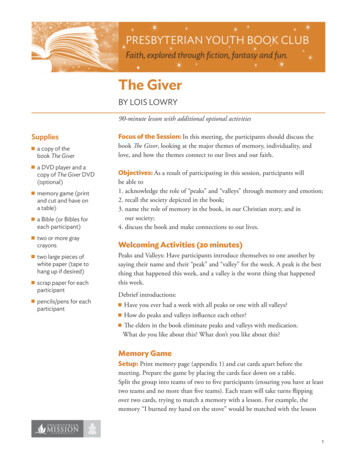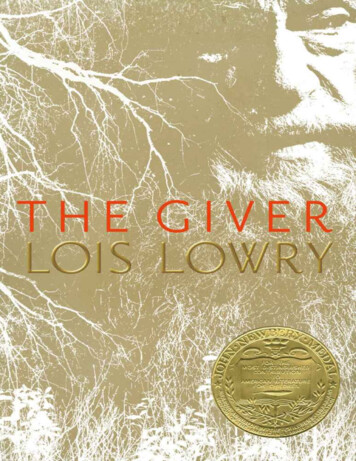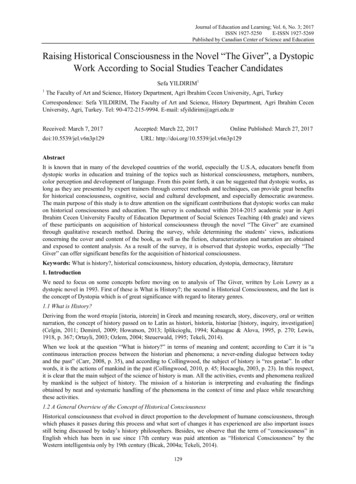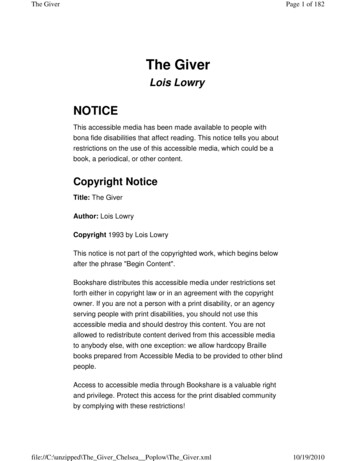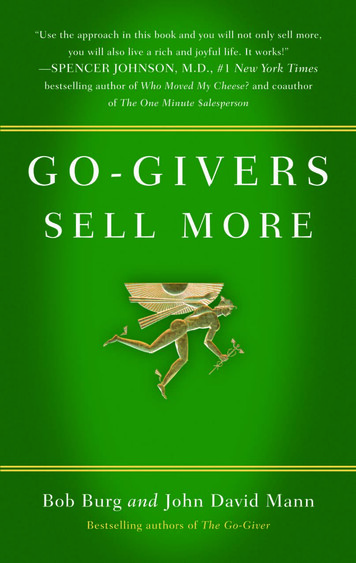
Transcription
Introduction:The Truth About Selling“I’m no good at selling!” Have you ever heard someone saythat, or perhaps said it yourself? We hear it all the time.Everyone who is not in sales thinks, “I could never sell.”Truth is, most people who are in sales secretly think thesame thing.There is a reason people feel this way: most of us look atsales backward. We may see it as convincing people to dosomething they don’t want to do. But it isn’t; it’s about learning what people do want to do and helping them do that. Or,we may think it’s about taking advantage of others—whilein fact, it’s about giving other people more advantage.But the biggest inversion of all, the great upside-downmisconception about sales, is that it is an effort to get something from others. The truth is that sales at its best—thatis, at its most effective—is precisely the opposite: it isabout giving.Selling is giving: giving time, attention, counsel, education, empathy, and value. In fact, the word sell comes fromthe Old English word sellan, which means—you guessedit—“to give.”This is not how most of us have come to think about19781591843085 GoGiversSell TX.indd 11846211/18/09 9:29:20 AM
G O - G I V E R s s e l l m oresales. Typically, sales is taught as a set of specific skills,reinforced by a range of techniques, aimed at putting yourproduct into someone else’s hands and their dollar intoyour pocket. From the prospecting dialogue and qualifyingquestions to overcoming objections and closing the sale, everystep of the process is mapped out and nailed down. All youhave to do, so the idea goes, is thoroughly learn and carefully practice everything in the salesman’s bag of tricks,and you too will become a sales success!At least, that’s the theory. But it often doesn’t work outthat way.Here is the reality: of the hundreds of thousands of entrepreneurs, small business owners, corporate salespeople,independent reps, and others in business who find themselves fulfilling any sort of sales function, most are havinga hard time with sales and selling.This difficulty does not typically come from a lack ofbelief. Most people who are involved in sales genuinely believe in what they’re selling. They are excited about thevalue they can add to other people’s lives while makinga healthy living for themselves and providing for theirfamilies.But when it comes to the actual selling part? Most ofus don’t believe we’re any good at it. We get performanceanxiety or don’t feel comfortable with the idea of “pitching.” We don’t like having things pushed on us, and don’treally expect others to like it either.We want to sell—we just don’t want to be in sellingmode.If this describes you, even a little bit, then much of whatyou’re about to read may surprise you. The approach in29781591843085 GoGiversSell TX.indd 21846211/18/09 9:29:20 AM
i n t ro d u c t io nthis book may even seem backward compared to what youhave learned before about sales. For example: Instead of “adding value” after the sale or as an incentiveto close a difficult deal, our model starts with adding valueand makes that its principal goal throughout. The classic sales process culminates in the “close.” Oursfocuses on the “open.” People typically think of sales as a talking business. Ourapproach is to spend less time talking and more timelistening. Conventional sales training focuses on the presentation:how you talk about your product. Ours focuses on asking great questions and keeping the conversation focusedon others. The classic sales process succeeds if you “make a sale”and fails if you get a “no.” Our sales process starts withthe understanding that it is impossible to “make asale”—yet it is designed so that you will have a positiveoutcome 100 percent of the time, whether or not a salehappens.Perhaps the biggest difference in what we describe herehas to do with the concept of control. The traditional approach to sales, reinforced and fine-tuned by dozens ofcarefully honed techniques, aims to choreograph the process by putting control firmly in the hands of the salesperson—which is probably why neither party really enjoysit: it’s not much fun to have someone try to control you.39781591843085 GoGiversSell TX.indd 31846211/18/09 9:29:20 AM
G O - G I V E R s s e l l m oreFor that matter, it’s not much fun to be the one doing thecontrolling, either.The traditional sales process is typically viewed as a sequence of specific, controlled events:prospect qualify present overcome objections close follow up provide customer serviceGo-Givers Sell More takes a different approach. In ourview, the sales process goes something like this:create value touch people’s lives build networks be real stay openThese five steps correspond to what in The Go-Giver wecalled the Five Laws of Stratospheric Success, which alsoform the five parts of this book. We’ll refer to those fivelaws often in these pages and even quote the charactersfrom The Go-Giver—Pindar, Joe, Nicole, Ernesto, Sam,Debra Davenport, and others.In fact, this book is based squarely on the premise at theheart of The Go-Giver:Shifting your focus from getting to giving is not only anice way to live life and conduct business, but a veryprofitable way as well.Put another way: living with generosity creates a swelling tide that raises all ships. Not just yours; not just theother person’s; everyone’s.49781591843085 GoGiversSell TX.indd 41846211/18/09 9:29:21 AM
i n t ro d u c t io nBeing a giving person, as it turns out, is not just anagreeable idea; it’s also quite practical. People who graspand live the principles of giving not only live happier andmore fulfilled lives, they are also among the most successful people we know. Go-givers really do sell more.Now, we have a confession to make: these ideas did notreally originate with us. In fact, what we’re describingin this book is simply how every truly great salespersonoperates.When you spend time with a genuinely successful salesperson, pay close attention and you’ll find something surprising: none of the hundreds of standard sales techniquesare what makes them excel at what they do. Oh, they knowabout them, and when it will serve their customer, theymay utilize some of them. But what makes a great salesperson great at sales is that he or she is wholeheartedly interested in the other person.The truth about selling is that it’s not about your product, and it’s not about you—it’s about the other person.Genuinely great salespeople are not great because theyhave mastered “the close,” or because they give a dazzlingpresentation, or because they could shoot holes in any customer objection from fifty paces. They are great becausethey create a vast and spreading sphere of goodwill wherever they go. They enrich, enhance, and add value to people’s lives. They make people happier.But the most remarkable thing about these consummatesalespeople is that they are not as rare as you might think.In fact, you can find them everywhere. This is because be59781591843085 GoGiversSell TX.indd 51846211/18/09 9:29:21 AM
G O - G I V E R s s e l l m oreing adept at sales does not require mastery of complex orelaborate skills. As Debra Davenport says in The Go-Giver,“You want people skills? Then be a person.”This is very good news, because it means that anyonecan be great in sales. It means you can be great in sales.You might think that to do so, you need to have an outgoing, naturally jovial, gregarious personality. Not true.Shy people create relationships and get married. Introverts make great friends. You don’t need to be a “people person,” or any specific type of person, to be greatat selling. In fact, the idea itself—that you might have tobe a certain sort of person to be great in sales—preciselymisses the point:It’s not about you; it’s about them.If you take away nothing from Go-Givers Sell More butthose seven words, it will have been worth the effort forus to write it and for you to read it—because your life insales will transform. Focus on the quality of the relationship and on providing value to the other person, regardlessof “making the sale,” and you will create an exchange thatis both more satisfying and more profitable.That in a nutshell is the message of this book: it’s notabout you—it’s about them.“I loved the story about Pindar and Joe,” said one readerof The Go-Giver, “and how everything came together at theend of the book. But I can’t help wondering, does this stuffreally work—I mean, in real life?”69781591843085 GoGiversSell TX.indd 61846211/18/09 9:29:21 AM
i n t ro d u c t io nThis book is our answer to that question.It’s easy to get distracted by daily headlines and nightlynewscasts that focus on the exploits of the well-heeled corrupt in high places. But far from the TV camera’s glare, thegreat majority of genuinely successful people quietly carryon with their lives in ways that bear a surprising resemblance to Pindar, Ernesto, Nicole, and Sam.But don’t take our word for it. Our fondest hope is thatas you read Go-Givers Sell More, you’ll put its ideas to thetest and find out for yourself. And as you do, we inviteyou to share your experiences with our growing Go-Givercommunity in the Scrapbook section of the Go-Giver blog:www.thegogiver.com/scrapbook.And not only your experiences with sales. Because GoGivers Sell More is not just about selling more: it’s also aboutliving more. As Pindar tells Joe in The Go-Giver, “These lessons don’t apply only to business, Joe. A genuinely soundbusiness principle will apply anywhere in life—in yourfriendships, in your marriage, anywhere.”If you are in sales in any form—as an account exec at alarge firm, an independent rep working out of your home,a retail clerk, a professional marketing your own services—then this book is for you.And if you’re not in sales? Then this book is for you, too.It’s for anyone and everyone who at any point in the courseof everyday life finds themselves dealing with other human beings. Why? Because studying sales is really studying humanity. Understanding selling means understandinghow people work.Writing about The Go-Giver, one reviewer added this atthe end of his column:79781591843085 GoGiversSell TX.indd 71846211/18/09 9:29:21 AM
G O - G I V E R s s e l l m oreAs a side note, I handed The Go-Giver to my thirteenyear-old son and made it a required read. Even if henever touches a sales job or owns his own business, I dobelieve he will be a much better person because of it.The five principles explored in this book govern success in sales; they also govern successful friendships andpartnerships, marriages and families, and organizationslarge and small. This is because the laws that govern goodsalesmanship are the laws that govern good relationships.Selling is not at its core a business transaction; it is first andforemost the forging of a human connection.If your goal is to make a living through sales, then we’dlike to challenge you to set your sights higher. The idea of“making a living” has the sense of breaking even, of keeping your head above water. But you can do more than treadwater—why not soar?Most often a goal of keeping your head above water willonly end up sinking you. Approaching your work withthe attitude, “I hope I make enough to get by” is deadlyfor sales—because attitudes are contagious. Regardlessof what your particular product or service is, people aredrawn to you (or not) because of how you make them feel.They don’t simply want to buy your product, they want tobe uplifted, encouraged, changed in some way.Our purpose in this little book is to help you not simplysurvive but thrive—through your encounters with otherpeople, to enrich their lives on every level, and in so doing,to enrich your own life and the lives of everyone aroundyou as well. The goal is not only to make a good living, butto create a great life.89781591843085 GoGiversSell TX.indd 81846211/18/09 9:29:21 AM
The Five Laws ofStratospheric SuccessThe Law of ValueYour true worth is determined byhow much more you give in value thanyou take in payment.The Law of CompensationYour income is determined byhow many people you serve and how wellyou serve them.The Law of InfluenceYour influence is determined byhow abundantly you place otherpeople’s interests first.The Law of AuthenticityThe most valuable gift you have to offer is yourself.The Law of ReceptivityThe key to effective giving is to stayopen to receiving.99781591843085 GoGiversSell TX.indd 91846211/18/09 9:29:21 AM
9781591843085 GoGiversSell TX.indd 101846211/18/09 9:29:21 AM
I. The Law of ValueYour true worth is determined byhow much more you give in valuethan you take in payment.9781591843085 GoGiversSell TX.indd 111846211/18/09 9:29:21 AM
9781591843085 GoGiversSell TX.indd 121846211/18/09 9:29:21 AM
1. Create ValueI mean, no offense, but how does a hot dog stand manage to outrank the swanky sidewalk cafés in this neighborhood?— Joe*If you are hoping to learn how to make a sale, we needto make a disclaimer right here and now: in this book weare not going to teach you how to make a sale. We’re notgoing to do this for the simple reason that you can’t makea sale. No one can. It’s impossible to make a sale, becauseyou cannot really make other people do what you wantthem to do.If you cannot make a sale, then what can you do? Youcan provide the context that allows a sale to happen whenthe other person makes a purchase. This is not semantics;this is the secret of all great salespeople.Your job is not to make a sale but to create somethingelse: value. In fact, as a salesperson you can define your jobdescription in three words: I create value.*The brief excerpts that open every chapter in this book are all drawn from TheGo- Giver.139781591843085 GoGiversSell TX.indd 131846211/18/09 9:29:21 AM
G O - G I V E R s s e l l m oreValue is the relative worth or desirability of a thing tothe user or beholder. It is those qualities or characteristicsin a thing or experience that give it worth, importance, orpreciousness— especially as compared to its cost, whetherin dollars or other terms.Four- fifths of selling is creating value. The final one- fifthinvolves the sale itself; however, even when the sale happens, you don’t make that sale— you receive it. We’ll get tothe receiving piece of it in part V. For now, let’s look at thecreating part.If your goal— as a salesperson or any kind of person— isto create value for other people, how do you do that? Thereare a thousand ways. Here we’ll look at just five: excellence, consistency, attention, empathy, and appreciation.ExcellenceThere’s nothing like doing what you do well. When yousee your work as exchanging hours for dollars, it’s easy toslip into a mindset of doing a task just well enough to getby. When you see your work as creating value, somethingshifts.According to the Law of Value, the point is not to do justenough to get paid, it’s to see how much more value youcan create than what you are paid for. That translates intoexcellence.How do you greet people on the phone? How do youmanage your correspondence and email? How do youdress? How do you pronounce the other person’s name?You can create value for others by applying the principle of excellence to all the tasks of your trade. If you run149781591843085 GoGiversSell TX.indd 141846211/18/09 9:29:21 AM
Cre a t e V a l u ea hot dog stand, it means using the best ingredients (nevera stale bun, the crispest freshest pickles, only premiumall- beef franks), keeping the cart immaculately clean, andkeeping yourself that way, too.The point is not to hold yourself to an impossible standard of perfection. It is to invest yourself consciously ineverything you do, with an intention of bringing to bearyour greatest abilities to the task at hand. It is to create ahabit of excellence.When you stay at a Ritz- Carlton, you are never greetedwith a “Hey,” a “What’s up?” or a “How ya’ doin’?” Depending on the time of day, it will be “Good morning,”“Good afternoon,” or “Good evening.” When you thankan employee for something, the response will not be “Noproblem” but “My pleasure.” They say it like they meanit— and they do mean it. Simple. Impressive. What does itcost? Nothing. What does it create? Excellence. Any otherhotel or motel in the world could do the same thing and position themselves above the competition. But most don’t.Excellent, by the way, does not mean expensive. The ability to provide exceptional value is not limited to high- endbusinesses or those with luxury product lines. You can havea great food experience at an expensive fine dining establishment, a family deli, a neighborhood coffee shop— or ahot dog stand. Price and value are not necessarily the samething. In fact, when following this law, they never are.ConsistencyThe world is full of uncertainty. When people know theycan always count on you to deliver the same quality of ex159781591843085 GoGiversSell TX.indd 151846211/18/09 9:29:21 AM
G O - G I V E R s s e l l m oreperience, no matter what, you become an oasis of stabilitywithin their personal sandstorm of change.There is a restaurant in John’s area that serves prettygood food— sometimes. And sometimes not. John and hiswife, Ana, have been there three or four times. There’s another place that’s about twice as far away and in about thesame price range, but their food is always good. You canguess where John and Ana eat— and where they don’t. It’sworth the extra drive not to have to wonder how dinnerwill turn out.Whenyoucancombineboth— excellenceplusconsistency— you create truly exceptional value.AttentionBob uses a travel agent in Florida named Jim Hurlburt. Inthe Internet age, when we can all make our own reservations, you’d think travel agents would be obsolete— butBob would never dream of traveling without using Jim’sservice. Why? Because of the phenomenal value Jim creates through his attention to detail. He gets Bob exactlythe flights he wants at the times he wants and for the bestprices possible (and saves him a ton of time). He knowsBob’s seating preferences, he calls to let him know he gotthe upgrade— and if he couldn’t get it, he’ll keep tryingtill he does. He calls the airline to make sure everythingis running on schedule and keeps Bob up to date on anychanges.Before Bob leaves, Jim emails to wish him a good tripand make sure he has Jim’s cell phone number in case ofemergencies. When Bob returns, there’s an email waiting to169781591843085 GoGiversSell TX.indd 161846211/18/09 9:29:21 AM
Cre a t e V a l u ewelcome him home, make sure he had a good trip, and askif anything came up that would have made the trip easieror better for him.Not surprisingly, Bob has referred a lot of business hisway. The value Jim has created has made him worth a greatdeal to Bob and has paid Jim back in dividends many timesover.EmpathyEmpathy means putting yourself in the other person’sshoes.This is what happened to John and Ana a few years agowhen Ana broke her knee. It was a complex fracture andtook two full years to heal completely. During that timethey traveled a good amount and flew five different airlines, quite a few times each.When they flew Southwest, Ana was always taken ontothe plane first; wheelchairs were always ready for her whenthey got off the plane; and because she had to keep her legup for long flights, the flight attendants took care to makesure they got three seats across, with the empty seat in themiddle so she could put her leg up— even on flights thatwere practically full.Of the other four airlines, none came anywhere close tothis level of attentiveness; on one flight they were actuallyshuffled to the very back of the plane. The other airlinesgave decent service overall, but they missed so many simple opportunities to add more value. They just didn’t get it.They were neither trained nor inclined to put themselvesin the passenger’s place.179781591843085 GoGiversSell TX.indd 171846211/18/09 9:29:21 AM
G O - G I V E R s s e l l m oreAppreciationAdding value to people’s lives often costs little or nothingfinancially. In fact, most of the greatest ways we can createvalue for other people have nothing at all to do with spending money.One of the most powerful ways you can create valuefor people is simply to appreciate them. Notice the thingsthey do that make a difference, no matter how small, andpoint them out. Say thank you, and mean it. Write thank you notes— not just emails, but actual handwritten notes.(Who does that anymore?)At Marie Jakubiak’s accounting firm in Michigan, newclients are not simply greeted by name the first time theywalk into the office; they are also greeted by a sign thatsays, “Welcome to our new client, Mary Jones!” with theirname surrounded by fresh flowers.The word appreciate comes from the Latin appretiare,which means “to set a price to.” Over the centuries it cameto mean both “an expression of one’s estimate of something,usually favorable” and “to rise in value.”Interesting: when you appreciate people, you appreciate.And when you don’t, you depreciate.You want to increase your own worth? Appreciate.18Excerpted from Go-Givers Sell More. Published by Portfolio/Penguin. Copyright Bob Burg and John David Mann, 2010. All rights reserved.9781591843085 GoGiversSell TX.indd 181846211/18/09 9:29:21 AM
Writing about The Go-Giver, one reviewer added this at the end of his column: 9781591843085_GoGiversSell_TX.indd 7 11/18/09 9:29:21 AM. GO-GIVERs sEll mORE 8 18462 18462 As a side note, I handed The Go-Giver to my thir

